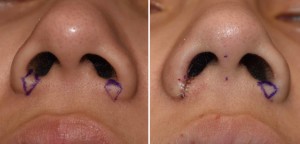Narrowing wide or flared nostrils can be a beneficial addition to some rhinoplasty procedures. This concept dates back to the name that is still used to describe it today, Weir wedges, from way back in 1892 when it was first described. At that time, the use of external alar wedge excisions was used to correct an unattractive alar flare. It was not until 1931 when narrowing of the alar base by using internal excisions from the nostril base and vestibular floor was first described. Its obvious benefit was to avoid the external scar that results from the traditional Wier wedge excision.
In assessing nasal base width, it is important to distinguish the width of the alar base and the degree of alar flare. The width of the alar base is the distance measured from one alar crease to the other, which ideally should equal the intercanthal distance. The alar flare is the degree of alar convexity above the alar crease.

A scarless technique for alar narrowing also exists which is the use of cinching sutures to pull the ala together from under the base of the nose. The major advantage of the cinching suture technique is that no external incisions are needed. However, many limitations are associated with the use of this technique for wide noses with excessive flaring because it may lead to bunching of the floor of the nostrils and excessive rounding of the alae. It can, however, be combined with excisions from the vestibular floor or the alar lobule to prevent some of these problems. It is a technique that I have found very useful in LeFort osteotomies at the time of closure but is of more limited use for ideal nostril narrowing.
Alar base narrowing is performed as the final step in rhinoplasty. This is because any narrowing of the nasal tip or any change in tip projection will have a direct effect on the alar base shape. Only after the closure of all rhinoplasty incisions can the amount of alar base narrowing be judged properly. It usually can be known before surgery that it will be a useful step in the rhinoplasty procedure.
Dr. Barry Eppley
Indianapolis, Indiana


